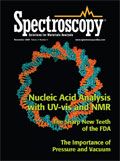A Stronger FDA: What Does It Mean for You?
The FDA, like the IRS or the DMV, is one of those governmental agencies that by its very nature can inspire many with at least a hint of dread. For one thing, it can often seem that they are only heard from when something bad is happening (that is, you haven't paid your taxes, you haven't paid a speeding ticket . . . or there is an inspection of your facility on the way).
The FDA, like the IRS or the DMV, is one of those governmental agencies that by its very nature can inspire many with at least a hint of dread. For one thing, it can often seem that they are only heard from when something bad is happening (that is, you haven't paid your taxes, you haven't paid a speeding ticket . . . or there is an inspection of your facility on the way).

David Walsh
Here at Spectroscopy, we leave the politics of the "Bush FDA" versus the "Obama FDA" to others, and instead focus on what is currently happening and how it impacts the laboratories and the daily work of our readers. In other words, we try to answer the question, "What does it all mean for me?" With this in mind, columnist Bob McDowall, one of the foremost experts on not only the FDA and its policies and regulations, but compliance in general, presents his take on the recent FDA Modernization Act and the posture of the FDA and its new commissioner, Margaret Hamburg, in general. Admittedly, the title of his column gives away his point of view to a large degree, as "The Tiger Has Sharp New Teeth" tells you where he thinks the FDA is headed. Tougher enforcement, shorter compliance times, and more appear to be on deck, but as always, Bob has answers and advice on how to succeed in this new environment. For whether you believe tougher regulation and enforcement is a good thing or a bad thing, the fact is that the laboratories of many readers will be forced to confront the coming changes regardless.
At Spectroscopy, we have always made it our mission to bring readers practical, nuts-and-bolts information to help them in their daily work, and this column, aimed at those on the frontlines of materials analysis, is just one more example of this mission in action. We hope you find this column and the other columns and technical research in this issue useful, and as always, feel free to contact myself or any one of our staff members at the e-mail addresses listed.
Enjoy the issue.

David Walsh
Editor-in-Chief

Fluorescence Spectroscopy Emerges as Rapid Screening Tool for Groundwater Contamination in Denmark
May 21st 2025A study published in Chemosphere by researchers at the Technical University of Denmark demonstrates that fluorescence spectroscopy can serve as a rapid, on-site screening tool for detecting pharmaceutical contaminants in groundwater.
China Institutions Team Up to Oxidize Toluene at Lower Temperatures
May 21st 2025Researchers from several Chinese universities have developed a low-cost, red mud-based catalyst doped with manganese oxides that efficiently oxidizes toluene at lower temperatures, offering a sustainable solution for air pollution control and industrial waste reuse.
The Future of Neurodegenerative Disease Research and the Role of IR Imaging
May 21st 2025In the final part of this three-part interview, Ayanjeet Ghosh of the University of Alabama and Rohit Bhargava of the University of Illinois Urbana-Champaign talk about the key performance metrics they used to evaluate their model, and what the future of neurodegenerative disease research looks like.
How THz and THz-Raman Spectroscopy Are Used in Drug Safety, Farming, and Mining
May 20th 2025A new review by researchers from IIT Delhi and the University of Queensland highlights how Terahertz (THz) and low-wavenumber Raman (THz-Raman) spectroscopy are advancing quality control and efficiency in pharmaceuticals, agriculture, and mineral industries. These powerful non-invasive tools enable detailed multi-parameter sensing, offering deeper insight at the molecular level.

.png&w=3840&q=75)

.png&w=3840&q=75)



.png&w=3840&q=75)



.png&w=3840&q=75)














